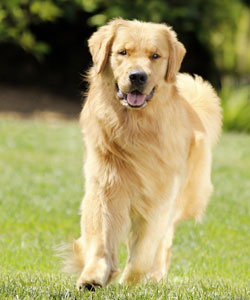Your Athletic Dog’s Diet

You can determine whether your dog eats enough calories based on his demeanor, appearance and weight. Does your dog seem depressed or lethargic? Does he seem less energetic than normal? Is he ravenous at mealtimes? If so, you may need to feed him additional food or higher energy foods.
Check your dog’s ribs and examine his body outline from an overhead perspective. If you see extra padding over his ribs and no sign of his waist, you are probably feeding too much. Cut down on the dog’s portions or bulk out his meals with lower-calorie foods, such as brown rice. If his ribs are starkly evident and his waist a little too pronounced, he needs more calories. Finally, invest in an accurate scale and weigh your dog on a regular basis. After a while, you’ll be able to pinpoint an ideal weight for your dog. Note that this weight may vary according to the seasons.
You’ll need to adjust the amount you feed on a weekly or even daily basis. The energy a dog requires varies with climate, amount of exercise, stress, breed and the quirks of each individual dog. Most veterinarians recommend you feed your athletic dog two to three meals each day, with the largest meal served at least an hour after the exercise session. A large meal before strenuous exercise can cause indigestion, cramps and other health problems.
You can provide the additional energy your active dog requires during the cold weather two ways: Feed more of the food you already give your dog, or feed him foods that are more tightly packed with nutrients.
To provide the highest level of energy, look for fatty foods. Fats yield more than twice as much energy as similar amounts of carbohydrates or proteins, and smaller amounts of food can supply a larger amount of energy. To help process these additional fats, your dog will also need higher levels of protein. In addition, you may add supplements to your dog’s diet to boost his energy levels and counteract the effects of vigorous exercise.
How much fat and protein should a dog have in his daily diet?
In general, high-energy homemade canine diets range from 15 percent to 25 percent fat, and from 30 percent to 40 percent protein; commercial high-performance diets offer 10 percent to 18 percent fat, and 24 percent to 28 percent protein. Whether you are feeding an off-the-shelf diet, making it yourself or some combination of the two, you can easily raise the fat levels your dog’s diet.
Two kinds of fat can be added to your dog’s diet: fat derived from animal sources, which are saturated fats, and fats derived from plant sources, which are polyunsaturated fats. Animal-derived fats offer the highest levels of energy and are the best high-energy supplements.
Plant-derived fats, easily available in vegetable oils, will make your dog’s skin and coat pretty, but they won’t add the desired energy jolt. Plant fats contain fatty acids, which are vital for healthy coats and shiny skin.
If your dog is active, but not super-active, try feeding him larger amounts of his regular diet before switching to the high-energy diet. If that doesn’t seem to satisfy your dog’s energy needs, try adding a little bit of fatty meat, such as chopped or ground beef heart, hamburger, fatty chuck, sirloin steak, lamb or pork, to his meals or increasing the use of fattier cuts of meat in your dog food recipe.
If your dog is super-active, you’ll have to add larger amounts of high-octane foods to his meals. One way is to save the meat drippings from your meals of roasted beef, chicken or turkey. (Be sure it does not contain sugar, artificial preservatives or chemicals, or high sodium levels.) You can also make special arrangements with your organic meat supplier to purchase fresh, pure poultry fat or beef tallow. Poultry fat is much preferred by owners of canine athletes because it is highly digestible and also contains the fatty acids that contribute to a shiny coat. Be careful when adding fat to your dog’s diet, though. If the dog eats solely the fat or too much of the fatty meat and not enough of his other food, it will lack necessary protein and carbohydrates.
« What Dog Breeds Have Five Toes on Their Hind Legs? Next Post
How to Find A Good Groomer »





